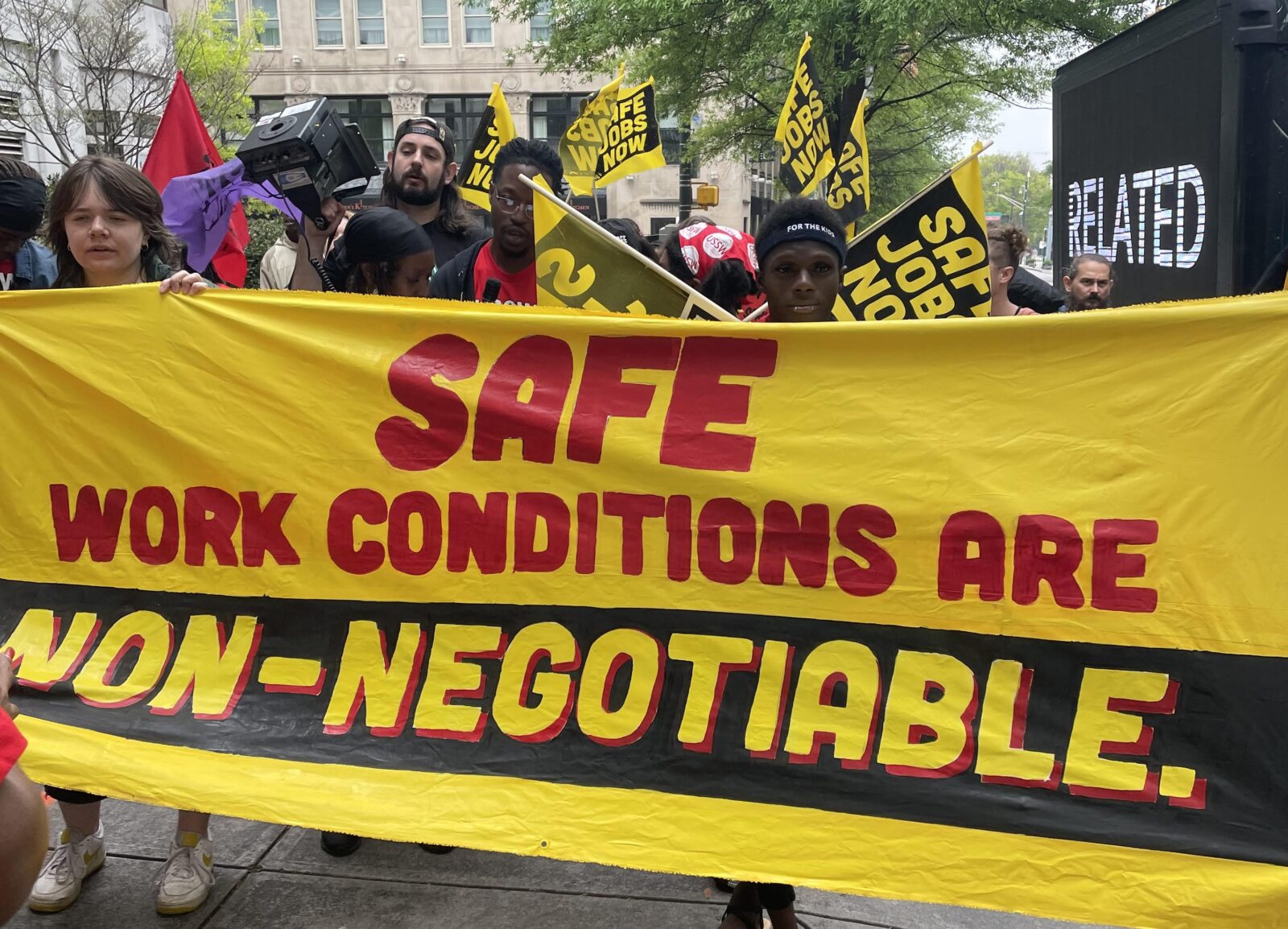May 22, 2024
U.S. Labor Unions Are Having A Moment
Assistant General Counsel, Service Employees International Union

The labor movement has been experiencing a recent renaissance in the American zeitgeist. Overall, a majority of Americans (55%) say labor unions positively affect the country. Millennials and Gen Z, the next generation of workers, are more pro-union than older generations, with Gen Z being the most pro-union generation alive today. Furthermore, in the past 24 months, we have seen huge labor wins including the Teamsters winning historic protections and wage increases for its UPS members, United Auto Workers winning 25% raises for employees’ new contracts with the Big 3 automakers, and nearly a million Americans receiving double-digit raises as a result of unionizing.
High unionization levels are associated with positive outcomes for workers and their communities. For example, union membership has been shown to narrow the racial wealth gap, by closing the distance between the wealth of white households and households of people of color. Women represented by unions earn 9.5% higher wages on average than non-unionized women with comparable characteristics. States with high union membership tend to have lower uninsured populations, are more likely to pass paid sick leave laws and paid family and medical leave laws, and have significantly less restrictive voting laws.
Despite these wins and favorable opinions and outcomes, nationwide union membership is still stagnant. In 2023, 11.2% of U.S. workers were union members, with only 6.9% of private sector workers being unionized. The disparity between support for unions and actual union membership numbers is largely a result of our outdated, weak, and historically racist labor laws. Before reviewing the current state of labor, it is necessary to review the historical context in which these laws were created and whom they were intended to benefit or not benefit.
Is Broken Labor Law Working as Intended?
Economic struggle has always been the cornerstone of the American landscape. At its inception, the country’s economic and social systems were created and built around the use of slave labor. Even when Black slaves were set free, they were met with racist state laws and physical violence to ensure that they continued to effectively work for free for their former masters.
Furthermore, when white supremacist legislatures were confronted with newly freed workers and a new voting electorate, they passed laws to prevent local labor regulation. Throughout the South, new Black citizens made up a majority or at least a sizable portion of the new electorate. With the fear of Black voters mobilizing and exercising power at the local level, state legislatures worked to consolidate power at the state level where white supremacy was stronger. This was done through preemption — a legal doctrine that gives higher governments, such as federal or state governments, the power to limit or block lower governments from legislating on specific issues.
Fast forward to the New Deal Era, when Congress passed supposedly “race-neutral" policies to help Americans recover after the Great Depression. However, racist Southern congressmen worked to exclude Black workers from the New Deal to preserve “the quasi-plantation style of agriculture” that pervaded the South. As a result, agricultural and domestic workers, primarily Black dominated industries, were excluded either explicitly or in practice from the Social Security Act of 1935, the Fair Labor Standards Act of 1938 (“FLSA”), and the National Industrial Recovery Act of 1933, which was the predecessor for the National Labor Relations Act of 1935 (“NLRA”). This meant that most Southern Black workers were excluded from old age benefits, unemployment insurance, minimum wage protections, maximum working hour restrictions, and other labor protections.
The present-day NLRA continues to exclude agricultural and domestic workers. In a similar vein, the NLRA and FLSA effectively exclude other workers from basic labor protections by limiting which workers and businesses are covered by these laws. Businesses have taken advantage of these loopholes by creating fissured workplaces through outsourcing, contracting or subcontracting, franchising, or outright misclassifying workers as independent contractors or supervisors. As a result, workers have limited power to make demands on businesses because they are unclear about who actually controls their working conditions.
Furthermore, the NLRA relies on an outdated model of unionizing which requires workers to organize worksite by worksite. However, many low-wage jobs, which again are disproportionately held by people of color, are unable to achieve such feats. For example, low-wage service jobs, such as those in the fast food and retail industries, experience high turnover rates and unstable scheduling, which makes it difficult for workers to build a community, much less run a successful union organizing drive at their workplace. Workers who still choose to organize their workplace despite these obstacles are likely to face long, drawn out negotiations to get a first contract or outright retaliation in the form of discipline, reduced hours, and even firing. Even worse, workers can wait months or even years to be reinstated or receive back pay after being discharged.
Not only do many workers face insurmountable obstacles to unionizing, but predominantly white state legislatures are still using preemption to prohibit local governments from raising labor standards, such as minimum wage standards that “would disproportionately benefit Black workers and other workers of color, as well as women and low-income workers.” Furthermore, several Southern states have also passed so-called right-to-work (RTW) laws that prohibit a union from collecting any fees from employees in a bargaining unit who are not members of the union, even though these non-members receive benefits from union contracts. These laws are used to diminish unions’ financial strength and in turn, their ability to negotiate better wages and working conditions. It is also no coincidence that Black workers in RTW states tend to have lower wages than those in states without RTW laws.
Case Examples of How Unions are Responding to Broken Labor Laws
Union of Southern Service Workers, Service Employees International Union
Southern workers face significant challenges when organizing their workplaces. The Southern economic model relies on low wages, anti-union laws, weak state-level labor protections (especially when compared to other regions), and a lack of government oversight to attract businesses. These tactics are clearly working because Southern states have some of the lowest rates of union membership in the country.
In 2022, the Service Employees International Union (“SEIU”) launched the Union of Southern Service Workers (“USSW”). USSW recognizes the challenges in organizing Southern low-wage service workers, including the continuation of racist laws, as well as the persistent use of the low-wage service sector model with its unstable scheduling and high turnover rates. To address these issues, USSW does not seek to unionize workers worksite by worksite under the NLRA’s framework. Rather, USSW is focused on cross-sector organizing at various stores in different industries including retail, warehouse, fast food, and home care.
With the support of USSW, workers are organizing across the South to address workplace issues regardless of their formal or legal union status. For example, Burger King workers in Atlanta, Georgia, held a rally to demand safe working conditions, saying that a broken air conditioner in their store resulted in high heat that posed health risks. Working in extreme heat conditions is a fairly common occurrence in many jobs across the country. Several other workers employed at different fast food restaurants and in different industries who were experiencing similar issues also spoke out at the protest. As a result of the protest, Burger King’s corporate office contacted the franchise that owned the store and told them to fix the air conditioning. This story shows the true power of USSW. One or two workers speaking out about workplace issues would have likely not resulted in any change, especially where the workers are directly employed by a franchisee but many of their working conditions are determined by the corporation. However, when multiple workers across industries band together, they can elevate their workplace demands.
Airport Workers United, Service Employees International Union
Likewise, labor unions and workers have had to adapt to organizing workplaces with the rise of contracting and subcontracting. For example, SEIU’s Airport Workers United (“AWU”) helps to organize low-wage airport service workers–including baggage handlers, cabin cleaners, fuelers, and airport wheelchair agents–many of whom are people of color and immigrants. Prior to the passage of the Airline Deregulation Act of 1978 (“ADA”), this group of workers was typically employed directly by the airlines. However, over the past two decades, airlines have almost entirely contracted out these jobs to airline service providers. Under a subcontracting model, the lowest bidder usually wins these contracts by reducing labor costs through lower wages and benefits for employees.
To combat this issue, the AWU implemented a dual strategy of organizing workers, as well as pushing for local living-wage measures that would apply to many airport service workers. This dual strategy was born out of concern that if the union negotiated raises for an airport contractor’s workers, then that contractor could lose out in competitive bidding to a non-union contractor that paid lower wages. This strategy proved successful and won raises and improvements for over 150,000 airport workers, including getting a $19 minimum wage for New York area airport workers.
However, this approach is not without its challenges. While some airport service workers have won higher wages and benefits under this approach, state or federal minimum wage requirements still govern many major airports. In several states, the federal minimum wage still controls and requires payment of only $7.25 per hour. Many local governments that want to pass minimum wage and other labor standards for airport workers are likely to be met with federal or state preemption challenges. To avoid a patchwork of various wage and benefits standards at U.S. airports, AWU has been advocating for national legislation such as the “Good Jobs for Good Airports Act,” which aims to ensure airport service workers in the United States receive a living wage and important benefits like health care.
How Can We Help Workers?
While workers and unions are learning to adapt to organizing modern workplaces, the takeaway lesson is that it should not be this difficult for workers to organize and win better wages and working conditions. It is imperative that we improve protections for workers. Congress must pass stronger labor laws including raising the federal minimum wage and eliminating loopholes in current labor laws. Likewise, Congress must also increase funding for agencies that are charged with helping workers, including the National Labor Relations Board and the U.S. Department of Labor. Similarly, state and local governments must enact higher labor standards and increase funding for their state labor agencies.
____________________________
 Dorothy Singletary is Assistant General Counsel at the Service Employees International Union.
Dorothy Singletary is Assistant General Counsel at the Service Employees International Union.
Collective bargaining, Labor and Employment Law, Workers’ Rights




